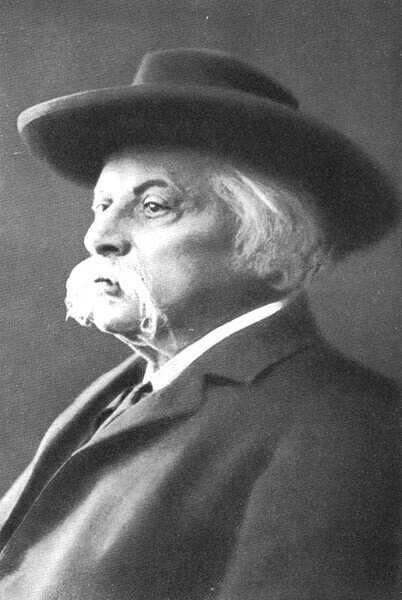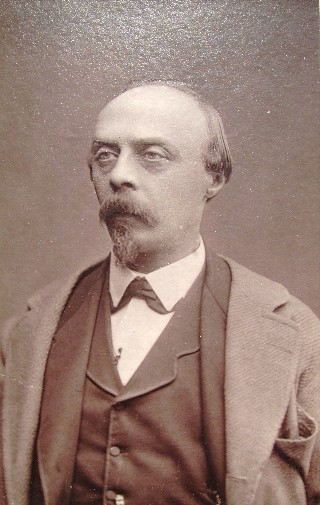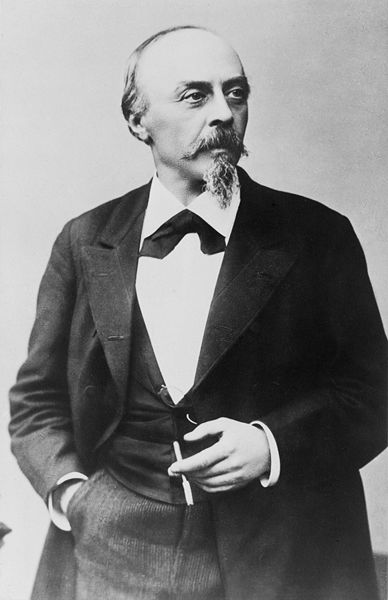<Back to Index>
- Composer Karl Goldmark, 1830
- Composer and Pianist Hans Guido Freiherr von Bülow, 1830
- Composer Johan August Söderman, 1832
PAGE SPONSOR

Karl Goldmark, also known originally as Károly Goldmark (Hungarian: Goldmark Károly) and later sometimes as Carl Goldmark; May 18, 1830, Keszthely – January 2, 1915, Vienna) was a Hungarian composer.
Goldmark came from a large Jewish family, one of 20 children. His father was a chazan to the Jewish congregation at Keszthely, Hungary. His early training as a violinist was at the musical academy of Sopron (1842 – 44). He continued his music studies there and two years later was sent by his father to Vienna, where he was able to study for some eighteen months with Leopold Jansa before his money ran out. He prepared himself for entry first to the Vienna Technische Hochschule and then to the Vienna Conservatory to study the violin with Joseph Böhm and harmony with Gottfried Preyer. The Revolution of 1848 forced the Conservatory to close down. He was largely self taught as a composer. He supported himself in Vienna playing the violin in theater orchestras, at the Carlstheater and the privately supported Viennese institution, the Theater in der Josefstadt, which gave him practical experience with orchestration, an art he more than mastered. He also gave lessons: Jean Sibelius studied with him briefly. Goldmark's first concert in Vienna (1858) met with hostility, and he returned to Budapest, returning to Vienna in 1860.
To make ends meet, Goldmark also pursued a side career as a music journalist. "His writing is distinctive for his even - handed promotion of both Brahms and Wagner, at a time when audiences (and most critics) were solidly in one composer's camp or the other and viewed those on the opposing side with undisguised hostility." Johannes Brahms and Goldmark developed a friendship as Goldmark's prominence in Vienna grew. Goldmark, however would ultimately distance himself because of Brahms' prickly personality.
Among the musical influences Goldmark absorbed was the inescapable one, for a musical colorist, of Richard Wagner, whose anti - semitism stood in the way of any genuine warmth between them; in 1872 Goldmark took a prominent role in the formation of the Vienna Wagner Society. He was made an honorary member of the Gesellschaft der Musikfreunde, received an honorary doctorate from the University of Budapest and shared with Richard Strauss an honorary membership in the Accademia di Santa Cecilia, Rome.
Goldmark's opera Die Königin von Saba ("The Queen of Sheba"), Op. 27 was celebrated during his lifetime and for some years thereafter. First performed in Vienna on 10 March 1875, the work proved so popular that it remained in the repertory of the Vienna Staatsoper continuously until 1938. He wrote six other operas as well.
The Rustic Wedding Symphony (Ländliche Hochzeit), Op. 26 (premiered 1876), a work that was kept in the repertory by Sir Thomas Beecham, includes five movements, like a suite composed of coloristic tone poems: a wedding march with variations depicting the wedding guests, a nuptial song, a serenade, a dialogue between the bride and groom in a garden, and a dance movement.
His Violin Concerto No. 1 in A minor, Op. 28, was once his most frequently played piece. The concerto had its premiere in Bremen in 1877, initially enjoyed great popularity and then slid into obscurity. A very romantic work, it has a Magyar march in the first movement and passages reminiscent of Dvořák and Mendelssohn in the second and third movements. It has started to re-enter the repertoire, through recordings by such prominent violin soloists as Itzhak Perlman and Joshua Bell. Nathan Milstein also championed the work and Milstein's recording of the Concerto (1963) is widely considered the definitive one. Goldmark wrote a second violin concerto, but it was never published.
A second symphony in E-flat, Op. 35, is much less well known. (Goldmark also wrote an early symphony in C major, between roughly 1858 and 1860. This work was never given an opus number, and only the scherzo seems to have ever been published.)
Goldmark's chamber music, in which the influences of Schumann and Mendelssohn are paramount, although critically well received in his lifetime, is now rarely heard. It includes the String Quintet in A minor Op. 9 that made his first reputation in Vienna, the Violin Sonata in D major Op. 25, two Piano Quintets in B-flat major Opp. 30 and 54, the Cello Sonata Op. 39, and the work that first brought Goldmark's name into prominence in the Viennese musical world, the String Quartet in B-flat Op. 8 (his only work in that genre).
Goldmark also composed choral music, two Suites for Violin and Piano (in D major, Op. 11, and in E-flat major, Op. 43), and numerous concert overtures, such as the Sakuntala Overture Op. 13 (a work which cemented his fame after his String Quartet), the Penthesilea Overture Op. 31, the In the Spring Overture Op. 36, the Prometheus Bound Overture Op. 38, the Sappho Overture Op. 44, the In Italy Overture Op. 49, and the Aus jungendtagen Overture, Op. 53. Other orchestral works include the symphonic poem Zrínyi, Op. 47, and two orchestral scherzos, in E minor, Op. 19, and in A major, Op. 45.
Karl Goldmark's nephew Rubin Goldmark (1872 – 1936), a pupil of Dvořák, was also a composer, who spent his career in New York.
Goldmark died in Vienna and is buried in the Zentralfriedhof (Central Cemetery), along with many other notable composers.


Hans Guido Freiherr von Bülow (January 8, 1830 – February 12, 1894) was a German conductor, virtuoso pianist, and composer of the Romantic era. He was one of the most famous conductors of the 19th century, and his activity was critical for establishing the successes of several major composers of the time, including Richard Wagner.
Bülow was born in Dresden, and from the age of nine he was a student of Friedrich Wieck (the father of Clara Schumann). However, his parents insisted that he study law instead of music, and sent him to Leipzig. There he met Franz Liszt, and on hearing some music of Richard Wagner — specifically, the premiere of Lohengrin in 1850 — he decided to ignore the dictates of his parents and make himself a career in music instead. He studied the piano in Leipzig with the famous pedagogue Louis Plaidy. He obtained his first conducting job in Zurich, on Wagner's recommendation, in 1850.
Notoriously tactless, Bülow alienated many musicians with whom he worked. He was dismissed from his Zurich job for this reason, but at the same time he was beginning to win renown for his ability to conduct new and complex works without a score. In 1851 he became a student of Liszt, marrying Liszt's daughter Cosima in 1857. They had two daughters: Daniela, born in 1860 and Blandine, born in 1863. During the 1850s and early 1860s he was active as a pianist, conductor, and writer, and became well known throughout Germany as well as Russia. In 1857 he premiered Liszt's great Piano Sonata in B minor in Berlin.
In 1864 he became the Hofkapellmeister in Munich, and it was at this post he achieved his principal renown. He conducted the premieres of two Wagner operas, Tristan und Isolde and Die Meistersinger von Nürnberg, in 1865 and 1868 respectively; both were immensely successful. However, his wife Cosima, who had been carrying on an extramarital affair with Richard Wagner for some time, left him in 1868, taking with her two of their four daughters, Isolde and Eva — the two whom Richard Wagner had fathered — and in 1870 divorced Bülow. In spite of this, Bülow remained a disciple of Wagner, and never seemed to hold a grudge; indeed, he mourned the death of Wagner in 1883, and continued to conduct his work.
In 1867 Bülow became director of the newly reopened Königliche Musikschule in Munich. He taught piano there in the manner of Liszt. He remained as director of the Conservatory until 1869.
In addition to championing the music of Wagner, Bülow was a supporter of the music of both Brahms and Tchaikovsky. He was the soloist in the world premiere of the Tchaikovsky Piano Concerto No. 1 in B flat minor in Boston in 1875. He was also a devotee of Frédéric Chopin's music; he came up with epithets for all of Chopin's Opus 28 Preludes, but these have generally fallen into disuse.
He was the first to perform the complete cycle of Beethoven's piano sonatas, which he did from memory, and he also produced a scholarly edition of the sonatas which is still in print.
From 1878 to 1880 he was Hofkapellmeister in Hanover but was forced to leave after fighting with a tenor singing the "Knight of the Swan [Schwan]" role in Lohengrin; Bülow had called him the "Knight of the Swine [Schwein]". In 1880 he moved to Meiningen where he took the equivalent post, and where he built the orchestra into one of the finest in Germany; among his other demands, he insisted that the musicians learn to play all their parts from memory.
It was during his five years in Meiningen that he met Richard Strauss (though the meeting actually took place in Berlin). His first opinion of the young composer was not favorable, but he changed his mind when he was confronted with a sample of Strauss's "Serenade." Later on, he used his influence to give Strauss his first regular employment as a conductor. Like Strauss, Bülow was attracted to the ideas of Max Stirner, whom he reputedly had known personally. In April 1892 Bülow closed his final performance with the Berlin Philharmonic (where he had been serving as Principal Conductor since 1887) with a speech "exalting" the ideas of Stirner. Together with John Henry Mackay, Stirner's biographer, he placed a memorial plaque at Stirner's last residence in Berlin.
Some of his orchestral innovations included the addition of the five - string bass and the pedal timpani; the pedal timpani have since become standard instruments in the symphony orchestra. His accurate, sensitive, and profoundly musical interpretations established him as the prototype of the virtuoso conductors who flourished at a later date. He was also an astute and witty musical journalist.
In the late 1880s he settled in Hamburg, but continued to tour, both conducting and performing on the piano.
Bülow suffered from chronic neuralgiforme headaches, which were caused by a tumor of the cervical radicular nerves.
After about 1890 his mental and physical health began to fail, and he
sought a warmer, drier climate for recovery; he died in a hotel in Cairo, Egypt, only ten months after his last concert performance.
(Johan) August Söderman (17 July 1832, Stockholm – 10 February 1876, Stockholm) has traditionally been seen as the pre - eminent Swedish composer of the Romantic generation, known especially for his lieder and choral works, based on folk material, and for his theater music, such as the incidental music to Ludvig Josephson's Marsk Stigs döttrar ("Marshal Stig's Daughter"), 1866, or his Svenskt festspel ("Swedish Festival Music").
The son of a musical father and a pupil of the Royal Swedish Academy in Stockholm, he studied piano, but mastered the oboe and violin as well. In 1856 – 57 he studied counterpoint at the Leipzig Conservatory with Hans Richter; there, in a musical culture that bore the imprint of Mendelssohn, he became familiar with the music of Robert Schumann and also with that of Richard Wagner. On his return to Stockholm he worked as a theater conductor, and at the Royal Swedish Opera as choirmaster and eventually assistant conductor.
He wrote several operettas (The Devil’s First Try, 1856) and incidental music for about 80 plays, such as a Swedish translation of Schiller's Die Jungfrau von Orleans ("The Maid of Orleans"). His influence can be detected in the music of later Swedish Romantic composers, Hugo Alfvén and Wilhelm Peterson - Berger.
Söderman was only 44 when he died. His music is virtually unknown outside Sweden.